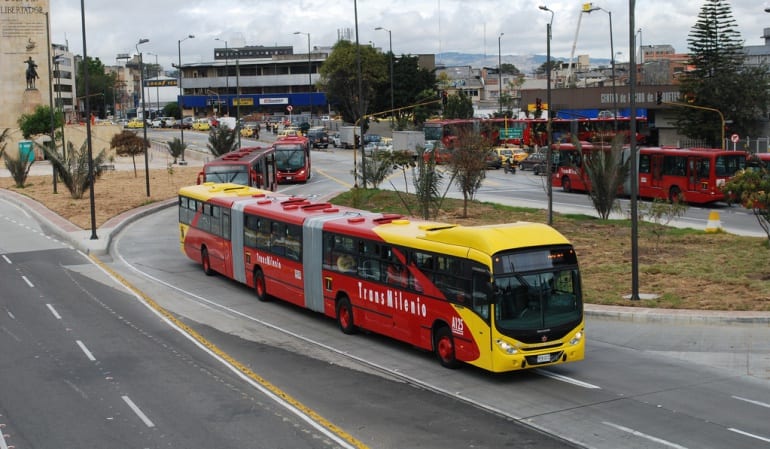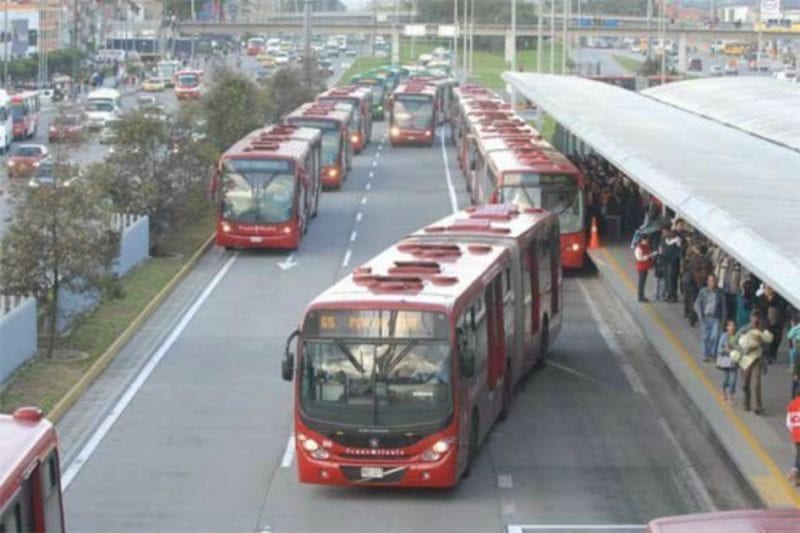Bogota on Wheels: Chronicle of a Cuban Riding the Transmilenio

HAVANA TIMES – I thought I knew Bogota because I had already been twice in 2016. I was wrong. On both of those visits, I only went where I could get to on foot and, therefore, I never went onboard the Transmilenio. That’s why I can’t say that I knew Bogota. Even if you go to Monserrate, the Salt Cathedral, Carrera Septima, the Primatial Cathedral of Bogota, Avenida Caracas and even the Theatron nightclub, you can’t say you know the Colombian capital if you haven’t been on the Transmilenio.
“Bogota is Latin America’s only big city without a metro. We have the Transmilenio, which is brutal,” a friend from Bogota complained two years ago. I guessed he didn’t consider Havana to be a big city because we don’t have a metro either. In our capital, there was a project to build a metro, which resources were set aside for and it was very much promoted in the 1980s. Like other great revolutionary plans, the project was abandoned a short while after it began.
I had already seen those big, red buses moving around Bogota and, at simple sight, they just seem like a bigger version of our urban P buses (although they are double-articulated)
When Carlos, a Cuban friend led me and another friend of ours across a pedestrian bridge, to our first experience on the Transmilenio, as I come from Havana and am well-trained in Cuban public transport, I got ready to reach a stop outside, crowded to the curb with people and ready to run because the bus, I mean Transmilenio, would stop away from the bus stop or it just wouldn’t.
I soon discovered that my training was in vain. At the end of the bridge, a long metallic and covered structure was waiting for me, which protects people from rain, cold or sun, while waiting for the bus, which comes every 7 minutes.
There are several entrances along this structure, and on top of each one, there is a sign saying which bus stops there. When the bus appears and its doors open, they coincide with the entrances along the bus station, as if by magic. If it is very full and not many people get off, you wait for the next one. If the bus that comes isn’t the one you are waiting for, you move aside so that other passengers can get on.
As if that wasn’t enough, there is also an app called TransmiSitp, an independent initiative to help people move around on this mass form of transport or by taxi. It not only tells you which bus lines take you where you want to go, it also tells you how long it will take you.
During your journey, it tells you where it is along the route and how many more stops you have. If you don’t have the app installed on your phone, or you don’t have a phone (I don’t know about here in Colombia, but here in Cuba there are still people who don’t have a cellphone or a phone that is modern enough for you to download certain apps), the bus’ stops are announced by a voice and appear on a small screen. Another advantage of the Transmilenio is that it has a designated lane on the road. On my first trips, I asked myself what it was that my friend from Bogota found brutal.
In order to access what I considered paradise on Earth (used to having to wait long periods of time outside and having to run a lot of the time), you have to pass through a turnstile. This lets you in after you place your Transmilenio card, which you have to pre-buy and charge up with the number of journeys you want. On top of the turnstile, there is a small screen which tells you how many journeys you have left. “It’s important to always have at least one, because if it’s your last one, you need to buy another card,” Carlos warns.

The card costs 10,000 Colombian pesos, which is the equivalent of 4 USD more or less, depending on the exchange rate. Each trip costs 2,300 Colombian pesos, just under a dollar. Access to paradise isn’t exactly cheap, but it seems most people living in Bogota can afford it, as the Transmilenio transports approximately 2,455,705 people per day. If you bear in mind the fact that you can change bus at the bus interchange to get where you need to go without paying a single peso more than the original 2,300, it really is quite cheap, although it isn’t for everyone. We saw some people hanging around the station and climbing over to avoid the turnstile.
There is a cheaper way to travel on it. At bus stations, near the turnstile, there are people who offer you journeys for 2000 pesos. They place a card on the turnstile and “open, sesame”.
A girl mistook our friend Carlos for one of these people. Logic would tell you that if somebody gets through for less money than the official rate, money is being lost. Carlos discovered how it works. “They use stolen cards; they pickpocket them off someone, and then they use them to sell tickets a little cheaper,” he tells us. That is to say, the good life is expensive; it can be cheaper… but it’s illegal.
Performances on wheels
But you’re not only paying for your journey, you’re also paying for a kind of performance on wheels. We saw a rapper who was so good that we were asking ourselves why he wasn’t performing on a stage, a young man who was accompanied by background music and played romantic music quite well; others played their own instruments while they sang.
Some of them sang alone while others sang in a duet, in a trio or quartet. People give some of them money out of pity rather than because of their talent, like a blind man who had also lost his leg and was accompanied by his wife who was also blind. Another blind man who played the flute was quite nice to listen to.
A young man who displayed his vast knowledge about the history of this country also caught our attention and proved just how ignorant passengers were. Another man entertained us with mind games, he gave winners woven bracelets. At the end of each performance, we passengers gave them some coins and they moved onto another part in the bus or got off when we got to the interchange and boarded another bus. There were also people selling sweets, pens and notebooks. They were almost all men. I only saw one young woman selling pens the whole time I was on the Transmilenio.
Venezuelans who had fled the crisis in their country also formed part of this cast. They each told a story that was sadder than the one before: a young man who had left Venezuela because his monthly earnings weren’t enough to feed his children even for one day; a man who came with his pregnant wife, another son and a pocket full of useless bolivars; another who had left his sick mother behind in Venezuela hoping to be able to send medicines and money back for her so that she could at least eat. Another hoped to find work and bring his wife and children, but he hadn’t been lucky.
Colombians watched them bored. They have been listening to so many of these stories for over a year that they have become immune. But, we were inevitably moved. In Cuba, the multinational TV channel Telesur told me about Venezuelans who went back to their country because of the problems and abuse they faced where they had emigrated to. It didn’t tell me about the reasons why they left Venezuela in the first place.
Isabela Gutierrez is a 20-year-old Venezuelan who crossed the border just seven months ago. She sings and plays four instruments: piano, guitar, percussion and the cuatro. She makes a living by playing music on the street with other fellow Venezuelans and tells me that she also plays on the Transmilenio quite regularly.
“When I arrived seven months ago, it was cool because we could get quite a bit. But, as so many Venezuelans have come to do the same thing: get on the Transmilenio to ask for money and sell whatever they can, well it’s a little more difficult. We don’t earn the same as when we first arrived.” By the first trimester of 2018 alone, over 935,000 Venezuelans had arrived in Colombia, according to official statistics.
Soon my friends and I realized that we had been traveling on a form of transport (cheaper than a taxi or Uber) to save money, but we ended up giving away coins every time we got on a bus or walked along a pedestrian bridge, where we also found people begging or selling something.
One time, I took the Transmilenio at 7 PM, in the middle of the week, and I understood what my friend from Bogota meant when he said it was brutal. There were so many people at the station that I couldn’t get off, I literally couldn’t take a single step. Those who had just gone through the turnstile to get on the buses couldn’t move forward; those of us who were trying to get out of the station couldn’t move either. It took me over 15 minutes to get out of there.
I was lucky. Another friend from Bogota told me that when the Transmilenio is so full, you run the risk of being pickpocketed. If it’s very empty, the danger is that someone gets on and takes everything you have on you at gunpoint. Paradise can quickly become hell.

I found it amazing that there is a form of publc transport with a lane of traffic all for itself, that runs every 7 minutes on average, yet it isn’t enough in a city where there are also so many private cars, taxis and Ubers.
That’s because when the Transmilenio was opened to the public (December 4, 2000), Bogota had just over 6 million inhabitants. Today, there are almost eight million (some people in Bogota think that if you take the Venezuelans into account, there are almost ten million). Many came to the capital in the past after being displaced from their cities as a result of the armed conflict, a taxi driver who was taking me to the airport told me. We had time to talk, we were trapped in a traffic jam. Which is usual in Bogota, especially when it’s raining.
The driver asked me if there were traffic jams in Cuba. Naive. In Cuba, there aren’t enough cars to have a traffic jam! While having a car is a luxury in Cuba, cars have become so accessible in developed cities that they have become a problem, due to traffic jams and pollution.
Public transport is without a doubt the solution. But, not an inefficient and insufficient one like the one we have in Cuba. With all of its virtues and flaws, the Transmilenio is an example of what you can do in a city without a metro system. But, you’d have to first start off by repairing the roads as their poor state is one of the main causes of traffic accidents in Cuba.





